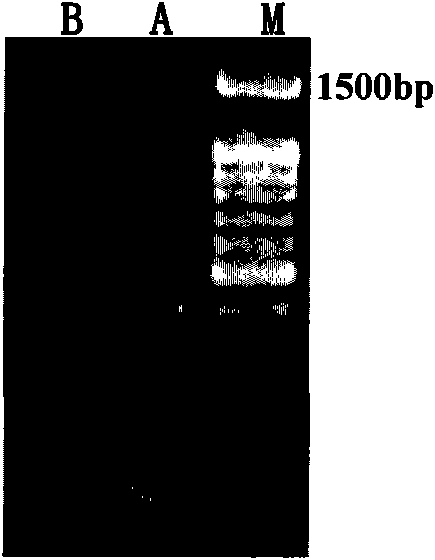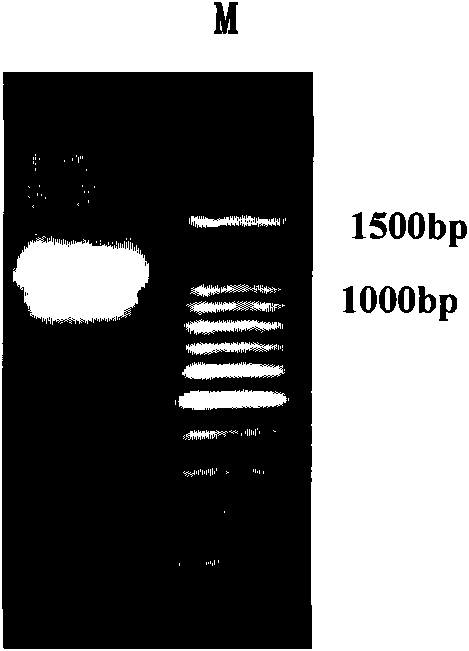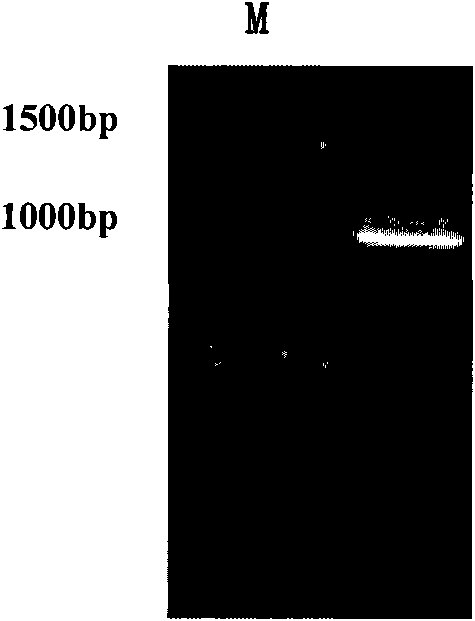Fe(II) transportproteins of peanut nodule and coding genes thereof
A transport protein and nodule technology, applied in the fields of physiology, genetic engineering, and molecular biology, can solve problems such as environmental pollution, threats to human health, ecosystem balance and stability, food safety, etc., achieve great application prospects, and increase the iron content of legumes. The effect of utilization efficiency
- Summary
- Abstract
- Description
- Claims
- Application Information
AI Technical Summary
Problems solved by technology
Method used
Image
Examples
Embodiment 1
[0046] Embodiment 1 The acquisition of peanut root nodule Fe(II) transporter protein and its coding gene
[0047] 1. Obtaining peanut nodule materials
[0048] Wash the peanut seeds with deionized water, soak them in 10% hydrogen peroxide for 20-30 minutes, wash the seeds with high-purity water, then soak them in saturated calcium sulfate for 6-7 hours, take out the seeds, wash them and put them on on the wetted absorbent paper in the tray, and then cover the wetted absorbent paper to avoid light and accelerate germination; after the seeds are white, soak them in the rhizobia solution for 20 minutes (the concentration of the bacteria solution is 1×10 7 cells / ml) for inoculation, and then sow the inoculated seeds in quartz sand to avoid light. After the flower grows two cotyledons, the peanut plant is moved into the low-nitrogen nutrient solution that promotes the formation of root nodules for cultivation. The nutrient content in the nutrient solution is: KNO 3 (3.2mM), KH 2...
Embodiment 2
[0117] Example 2 Yeast Heterologous Functional Complementation Validation of AhDmt1 Gene Function in Peanut Root Nodule
[0118] 1. Preparation of main reagents and medium formula:
[0119] 1. Preparation of main reagents
[0120] 1.0M LiAC: Adjust the pH of 10.2g LiAC to 7.5 with dilute glacial acetic acid, add water to make up to 100ml, sterilize at 121°C for 20min, and store at room temperature;
[0121] 50% PEG: add 50g PEG3350 to 100ml with water, sterilize at 121°C for 20mins, store at room temperature;
[0122] 40% glucose: 40g glucose, add 100ml water, sterilize at 121°C for 20mins, store at 4°C;
[0123] 10mM BPDS: 0.1341g BPDS, add water to make up to 25ml, filter sterilize, store at 4°C;
[0124] 0.5 MEDTA: 3.6531g EDTA, add water to make up to 25ml, sterilize at 121°C for 20min, store at 4°C.
[0125] 2. Medium formula:
[0126] (1) Bacterial culture medium
[0127] LB medium: 10g tryptone, 5g yeast extract, 10g NaCl, 15g agar powder (solid), pH7.0;
[0128]...
Embodiment 3
[0177] Example 3 Analysis of AhDmt1 Gene Expression in Different Organs of Peanut
[0178] Peanuts were cultivated in water and inoculated with rhizobia to induce nodulation. The specific method was the same as before. Total RNA was extracted from peanut leaves, roots, and root nodules. The above RNA was reverse-transcribed into single-stranded cDNA. Using the single-stranded cDNA as a template and peanut 18S rDNA as an internal reference, the amplification primers are: 18S-F: 5'-CCGTCTCAAACAAGAACAAAACC-3', 18S-R: 5'-TCACACCAAGTATCGCATTTCG-3'; PCR amplification of peanut AhDmt1 The primers were: QDMT-F1: 5'-GTGCTGTTTCCTTTTCGCCTTG-3', QDMT-R1: 5'-AGTGTATCCATTGAAAGTCTTGAGT-3', and the expression of AhDmt1 gene in different organs of peanut was analyzed by RT-PCR. The analyzed instrument is ABI7000 fluorescent quantitative PCR instrument, and the quantitative analysis reaction system is shown in Table 14:
[0179] Table 14
[0180]
[0181] Reaction program: preheating at 5...
PUM
 Login to View More
Login to View More Abstract
Description
Claims
Application Information
 Login to View More
Login to View More - R&D
- Intellectual Property
- Life Sciences
- Materials
- Tech Scout
- Unparalleled Data Quality
- Higher Quality Content
- 60% Fewer Hallucinations
Browse by: Latest US Patents, China's latest patents, Technical Efficacy Thesaurus, Application Domain, Technology Topic, Popular Technical Reports.
© 2025 PatSnap. All rights reserved.Legal|Privacy policy|Modern Slavery Act Transparency Statement|Sitemap|About US| Contact US: help@patsnap.com



